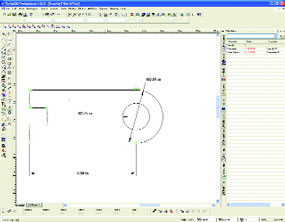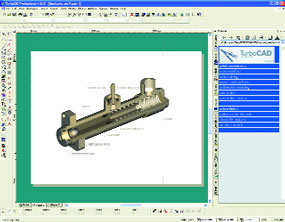Latest News
December 4, 2001
By David Cohn
It’s been several years since we last looked at TurboCAD Professional.In the interim, IMSI (Novato, CA; imsisoft.com) has added all sorts ofcapabilities. Last spring, for example, the company introduced TurboCADProfessional 10, which added LightWorks 7.3-based rendering and a hostof new mechanical design capabilities, including deformable 3D modelsusing NURBS, the ability to create solids from surfaces and surfacesfrom solids, facet editing of ACIS 3D objects, and axis-based scalingof ACIS objects. Since then, the programmers have been hard at work.TurboCAD Professional 10.5, introduced in mid-November, offers evenmore new features.

This time around, the big news is the addition of D-Cubed’s 2DConstraint Manager. These constraint capabilities enable users toestablish and control geometric and dimensional relationships betweendrawn objects. For example, you can constrain 2D objects so thatvertices remain connected, lines are always perpendicular, and an arcremains tangent to a given line. The new dimensional constraints enableyou to alter the size of an object by changing its dimension value.TurboCAD Professional 10.5 also now includes version 11 of Spatial’sACIS modeling kernel.
With all of these recent additions, a description of TurboCAD Probegins to sound increasingly like more-expensive MCAD modelingprograms, but descriptions can be a bit misleading.
Interface Showing Its Age
The TurboCAD interface remains largely unchanged since we last lookedat the software: a menu and several toolbars across the top of thescreen, several more toolbars along the left edge, status bar andinspector bar along the bottom, and a palette window along the rightedge. All of these components, with the exception of the status bar,can be undocked, resized, and floated anywhere on the screen. Butunlike other companies who have worked to simplify their productinterfaces, IMSI keeps adding toolbars; I counted a total of 60 in thenew release. The sheer number of tools can be quite daunting to newusers. For example, the arc toolbar provides 13 different buttonsrepresenting the many ways one can create an arc. By comparison, mostmodern programs use a single tool for drawing arcs and then present thevarious ways in which one might create an arc as options.
Twenty-five of those 60 toolbars also appear as flyouts from the mainDrawing toolbar, which includes not only 2D drawing commands but alsocommands for inserting raster images, creating 3D objects, controllinglights and cameras, performing Boolean operations, and a host of otherfunctions not usually grouped with drawing commands in other CADprograms. In addition, the toolbar icons are not always graphicallyintuitive; new users will need to rely on ToolTips.

TurboCAD’s developers could also do more to anticipate the waycustomers use the software. Object snaps are a prime example. Like mostCAD programs, TurboCAD can snap to significant geometry such as theendpoint of a line or the center of a circle. But if you simply turn onvertex snap, TurboCAD rejects all other selections, displaying a dialogwarning that a snap mode is active and no valid snap point was found.At first, it appears that you must turn off the snap mode to select apoint other than a vertex, but TurboCAD can be configured to accept thecurrent cursor position when no valid snap point is selected. The keyis to enable this mode in the Drawing Aids dialog box. But while mostTurboCAD commands and dialog boxes can be accessed using severaldifferent tools or menu selections, this crucial dialog box can only bereached by right-clicking on the SNAP or GEO buttons on the statusbar—hardly intuitive.
Using Constraints
One of the new toolbars provides access to TurboCAD’s new constrainttools. Available geometric constraints include coincident, parallel,perpendicular, tangent, equal, and so on. You can apply constraintsselectively to existing geometry or use the auto constraint tool toapply multiple constraints to selected 2D objects. As constraints areapplied, small glyphs appear in the drawing adjacent to the constrainedgeometry. If auto add constraints is enabled and you subsequently use atool such as Fillet, TurboCAD automatically adds the appropriateconstraint. For example, adding a fillet automatically adds bothtangential- and point-coincident constraints. Constraints are placed ona special non-printing layer and can be selected and deleted just likeany other drawing object. Curiously, you can’t constrain a rectangleunless you first explode it into its primitive parts.
Users can also apply dimensional constraints, dimensions thatthereafter control the size of objects (often called driving dimensionsin other programs). Again, if the auto add constraints function isenabled, TurboCAD can automatically convert appropriate dimensions intodimensional constraints. For example, if you select the paralleldimension tool and then dimension a line segment, the dimension createdis actually a dimensional constraint. Although initially set to thecurrent length of the segment, subsequently changing its value changesthe length of the line.

Dimensional constraints appear no different than other dimensions,however. In order to use dimensional constraints, you must openTurboCAD’s calculator palette. When you add a dimensional constraint,TurboCAD automatically adds a variable to the calculator palettecontaining the value of the dimension. If you then change the dimensionvalue in the calculator palette, the size of the object immediatelyupdates in the drawing. You can also change the name TurboCAD assignsto the variable and create formulas to establish mathematicalrelationships between variables. For example, you can dimension anobject so that its length is twice its width. Once you’ve added adimensional constraint, however, you can no longer change the length ofthe object by dragging its control points within the drawing.
Constraints can also be used when creating 3D objects. For example, youcan define a 2D sketch and an extrusion path, apply constraints toboth, and then extrude the sketch along the path. If you assigned adimensional constraint to the extrusion path, you can change theextrusion distance by changing the dimension value in the calculatorpalette. This is far from the smooth interaction found in most solidmodeling programs, however, in which the extrusion distance isautomatically a parameter that can be altered at will.
Working in 3D
TurboCAD’s other 3D capabilities are quite extensive for a basic CADprogram, but again pale in comparison to most popular solid modelingprograms. For example, you can extrude any closed profile to create asolid, while extruding an open profile creates a surface. If you’veenabled the program’s part tree, each operation—such as extrude, shell,fillet, and so on—appears in this hierarchical tree. You can modifysolids by editing these operations, but you can’t reorder theoperations. This makes the part tree quite limited.
For example, I created a solid based on a constrained 2D profile and anextrusion path to which I added a dimensional constraint. I thenshelled the solid. When I added a fillet blend along an edge, a portionof the shelled solid was removed. In a true history-based modeler, Icould have simply reordered the tree so that the blend occurred beforethe shelling operation. But I couldn’t do that in TurboCAD. Although Icould use the Undo command to step back through the operations so thatI could add the blend and then shell the solid, deleting the shelloperation from the part tree caused the entire solid to be deleted fromthe drawing.
New Features, New Price
While constraints garner most of the attention in the latest release,there are other new features as well. According to IMSI, the hatcheditor has been improved and users can create their own custom hatchpatterns. The multi-line text editor has also been enhanced and newselector options let you constrain movement of 3D objects along the x,y, or z axis by grabbing the object on the axis.
With all the additions, IMSI has raised the price of its software by$100, to $895. Users can upgrade from TurboCAD Professional version 10for $50. But a quick check of IMSI’s website reveals that you can buy anew copy of TurboCAD Pro 10.5 for as little as $749.
TurboCAD Professional is a good CAD tool. It’s got lots of advancedfeatures aimed at both the AEC and MCAD markets and is more powerfulthan many other general-purpose CAD programs costing considerably more.It’s also quite compatible with a wide range of programs, supporting 28file formats including AutoCAD (DWG and DXF) and MicroStation (DGN), aswell as IGES and STL.
For those who also need CNC capabilities, IMSI sells TurboCADCAM. At$895, this program includes support for milling, drilling, and latheoperations. TurboCADCAM offers many of the same features as TurboCAD,while adding machining and simulation and the ability to produce nativeG code using a wizard-like interface.
But even with the latest additions, TurboCAD Professional 10.5 is not aMCAD modeler. It still lacks true feature-based modeling, assemblymodeling, and sheet metal. If you’re looking for a good CAD tool, aninexpensive alternative to market-leader AutoCAD, TurboCAD Professionalhas much to offer. Just don’t expect it to be an alternative toprograms like Inventor, SolidWorks, or Solid Edge.
Contributing Editor David Cohn is a computer consultant and technicalwriter based in Bellingham, Wash. He’s Editor-in-Chief of EngineeringAutomation Report and CADCAMNet published by Cyon Research, and theauthor of more than a dozen books. You can contact him via e-mail sentto [email protected].
TurboCAD Professional 10.5 lets you constrain geometry and usedimensions to drive the size of objects. Dimension variables andformulas are controlled from within the Calculator palette.
Users can perform many of the functions found in solid modeling
programs, adding each operation to its part tree. But the tree cannot be reorderedand the solid is not fully editable.
IMSI
TurboCAD Professional 10.5
Novato, CA
imsisoft.com
System Requirements:
Windows 98/ME/2000/XP/NT4
Pentium II or higher
(1.6+ GHz recommended)
128MB of memory
(256MB recommended)
55 to 220MB hard disk space
Super VGA 1024 3 768
(3D graphics accelerator
recommended)
Price: $895
TurboCAD mimics AutoCAD’s use of multiple paperspace layouts. Thepalette area provides access to tutorials, which are presented asweb-based animations.
Subscribe to our FREE magazine, FREE email newsletters or both!
Latest News
About the Author
David Cohn is a consultant and technical writer based in Bellingham, WA, and has been benchmarking PCs since 1984. He is a Contributing Editor to Digital Engineering, the former senior content manager at 4D Technologies, and the author of more than a dozen books. Email at [email protected] or visit his website at www.dscohn.com.
Follow DE





